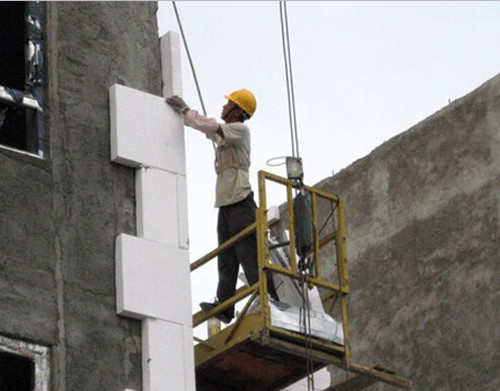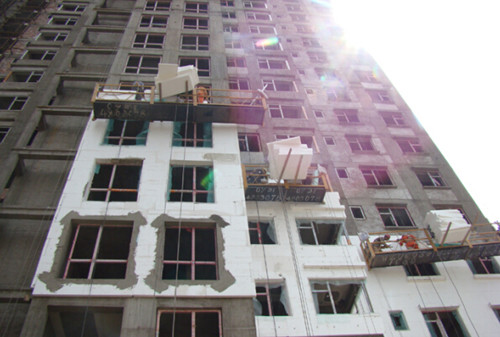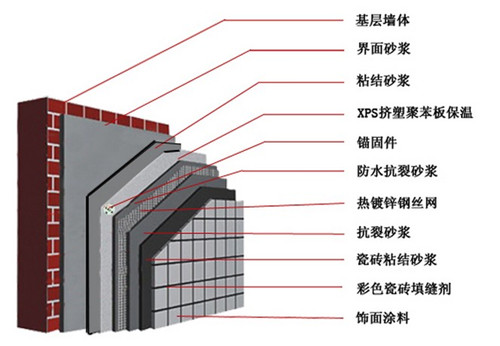External wall insulation construction technology and acceptance specification
To understand the external wall insulation construction technology , we must first understand what is the external wall insulation. The exterior wall insulation is various, and the traditional exterior wall insulation is compounded by polymer mortar, glass fiber mesh cloth, flame-retardant molded polystyrene foam board (EPS) or extruded board (XPS) and other materials. Site bonding construction. The new type of insulation and decoration integrated board is produced through assembly lines and integrates functions such as heat preservation, waterproofing, and facing. It is the preferred material for meeting the current energy efficiency requirements for building construction, improving the external wall insulation level of industrial and civil buildings, and also energy saving for existing buildings. The preferred material for the transformation. External wall insulation can have a certain degree of thermal insulation of the house, so that the house has a certain effect of Dongnuanxialiang, external wall insulation construction process how? May wish to follow me to learn about it! What are the external wall insulation materials First: Benzene plates and benzene plates are now used more often, but their thermal insulation effect is not ideal, and they will absorb water. Therefore, when using benzene plates, some waterproof measures are generally used. Second: extruded board, extruded board is much better than benzene board, thermal conductivity lower than the benzene board, the price is slightly higher. Third: Polyurethane is a kind of relatively high-end insulation material, and it is also the best kind of performance. Generally, it is used in some places where the requirements are extremely strict, and because it has a high price, there are fewer houses. Fourth: Glass wool and rock wool, glass wool and rock wool have many similarities in performance. Many people are also easily confused. However, because glass wool is better than rock wool, its price is generally higher than that of rock wool. External wall insulation construction scope 1. The scope of application of this regulation: Polystyrene board is used as insulation material, polymer adhesive mortar is used as bonding material, polymer screed mortar is used as wiping layer, and alkali-resistant glass fiber is coated with plastic mesh as reinforcing material and supplemented with card. Construction and acceptance of external insulation systems for external and external walls of industrial and civil buildings anchored by nails. 2. Requirements for product materials: The technical performance of all materials used in external wall insulation construction should meet relevant national standards. 3, construction personnel requirements: According to the project size and schedule requirements, organize the construction team. Prior to the start of construction, the construction personnel will be educated in thoughts, techniques, quality, and safety in order to ensure the quality of the construction project and the progress of the project. 4. Requirements for construction environment: The normal construction operating environment temperature for exterior wall insulation construction is 5°C~35°C. External wall insulation construction requirements 1. The construction and acceptance of the exterior wall and exterior doors are completed, and the base surface meets the requirements of relevant regulations. 2. The ambient temperature for the normal construction of external insulation systems is 5°C~35°C. 3, the construction site should be to achieve road access, water, electricity. 4. Construction erection tools and scaffolding shall meet the construction requirements and be safe and reliable. 5. The mobile distribution box and tap water pipes used in construction shall be configured according to the construction requirements. 6. Vertical and horizontal transport facilities for distribution materials are required to comply with relevant safety regulations. 7. The distance between the high-voltage electric wires and the construction site in the construction operating environment shall comply with relevant regulations and have corresponding protective facilities. 8. Remove all obstructions on the wall surface to be insulated. 9, the wind when the insulation board is not more than 5 levels. 10. To ensure construction quality, the construction surface should avoid direct exposure for a long time, and it should not be constructed in rainy days. 11, construction tools: slotting machine, wallpaper knife, screwdriver, scissors, ink fountain, brown brush, electric mixer, plastic, mixing barrel, impact drill, hammer, trowel, pallets, 2m on the ruler. External wall insulation construction points 1. Grassroots cleanup. Clean up the remaining floating ash, release agent oil and other debris on the concrete wall, as well as the empty parts of the plaster, and repair it. External walls are packed with various openings. It is required that the deviation of the surface flatness of the affixed polystyrene board should not exceed 4mm. When the deviation exceeds the deviation, the protruding wall surface should be ground and the recessed portion should be repaired. 2. Wall measurement, spring line, hanging line. According to the requirements of building facade design and exterior wall thermal insulation technology, horizontal and vertical control lines, retractable lines, and decorative stitching of external doors and windows are popped up on the wall surface. A vertical reference line is to be erected at the building's outer corners and other necessary places. Horizontal lines are placed at appropriate positions on each floor to control the verticality and flatness of the polystyrene board. 3. Paste the turn mesh. Wherever the exposed side of the exposed polystyrene board is exposed, the mesh cloth should be turned over. The 80mm width of the grid cloth not less than 200mm wide is firmly adhered to the base surface with special adhesive mortar, and the remaining grid cloth is overturned when the latter is pasted. 4. Stick the polystyrene board. The standard size of polystyrene board used for exterior insulation is 600mm×900mm and 600mm×1200mm. Non-standard size or local irregularities can be used to cut the corners of the entire wall to apply polystyrene board with a minimum size over 300mm. The patchwork of the benzene board cannot be left at the corners of the door window. Because the flatness of the base wall surface is not good enough, it is advisable to adopt the dot frame adhesion method. When the decoration is a coating method, the bonding area is not less than 40%. Do not apply adhesive mortar on the sides of the board. When the boards are arranged in a horizontal order, the upper and lower stitches are pasted together, and the yin and yang corners are to be handled by mistake. Even if the adhesive mortar that overflows the edge of the board is noticed when the board is adhered, there is no “bump gray†between the board and the board. Slots should be tightly stitched. When the slit width is more than 2mm, they should be filled with a corresponding thickness of polyphenylene. Patchwork height difference is not more than 1.5mm, otherwise it should be smoothed with sandpaper or special sanding equipment. 5. Anchors are fixed. When using a mechanical anchor to fix the polystyrene board, the installation of the anchor should be performed at least 24 hours after the adhesive mortar is used. The hammer is punched inwardly on the surface of the polyphenyl board. The hole diameter depends on the diameter of the anchor and the wall depth must not be less than the depth. Design requirements. Screw in or knock in anchoring nails, nail heads and discs must not exceed the board surface. 6. When the surface of the polyphenylene sheet seam is uneven, it needs to be primed with wood-lined coarse sandpaper. Grinding action requirements are: a gentle rotation in the circumferential direction, after grinding, use a brush to clear the polystyrene debris on the surface of the polystyrene board. 7. Apply the floor polish mortar. After the polystyrene board bonding and anchoring is completed and the experience is accepted, the polymer mortar is plastered. The surface of the polyphenyl board is smeared with a screed and the flanging cloth is pressed into the mortar. The reinforcing mesh cloth used in the four corners and the yin and yang corners of the door window was pressed into the mortar. 8. Lay a grid cloth. Tighten the grid cloth and stick it on the bottom screed mortar. Use a trowel to press the grid cloth into the mortar to obtain the surface layer with a trowel. It must be flat and compacted, and the grid cloth wrinkle is strictly prohibited. The grid cloth must not be pressed too deep. In the case of laps, the shop must meet the lap length requirements of 100mm horizontal and 80mm vertical. Before the ground mortar is coagulated, apply a trowel mortar cover to cover only the mesh cloth and microscopic mesh layout. Surface mortar should not be constantly rubbing, so as to avoid the formation of empty drums. External wall insulation construction technology First, tool preparation: Electric wire cutter or wallpaper knife, hand saw, ink fountain, 2m ruler, ruler, wood, tape measure, electric mixer, trowel, yin and yang corner rake, plastic mixing bucket, coarse sandpaper, 2m drag line Second, the construction conditions: 1. The construction site should have power and water-construction conditions and maintain a clean working environment. 2. When the surface layer is under construction, the on-site environmental temperature and the surface temperature of the grass-roots wall shall not be lower than 5°C, and the wind power shall not be greater than 5, and proper protection measures shall be taken during the winter season. 3, surface mortar construction, should avoid direct sunlight. When necessary, sun protection cloth can be placed on the construction scaffold to cover the construction wall surface. 4. During the construction of the rainy season, effective measures should be taken to prevent rainwater from scouring the walls. Third, polyphenylene particles external wall insulation construction technology: 1, the basic wall surface treatment: the wall should be cleaned, no oil, floating sink and so on. The wall surface is loose and the weathered part should be removed. If the surface protruding part is more than 8mm, it should be leveled. 2, brushing interface agent: For concrete walls and block walls should be painted interface mortar. 3, smear the first time the insulation mortar: glue powder polystyrene particles insulation mortar mainly consists of powder and polystyrene particles, two kinds of material bag packaging, when used by plastic powder material 25kg / bag; polystyrene particles 200L / bag ; Shimizu 35-40kg fully stir evenly, spread the well-mixed mortar on the wall, ram it in accordance with the design thickness, dotting, looking for vertical, the first time smearing 15-20mm thick and compaction to prevent emptying. The material should be used up within 4 hours of use. 4, smear the second round of insulation mortar: wipe the second time the insulation mortar should be spaced with the first time more than 24 hours, wipe the second time the direction of the first time with the vertical. The smear thickness can be leveled according to design criteria. 5. Divide the grid line and set the groove: According to the design requirements, pop up the position of the dividing line on the heat preservation layer, and use the wallpaper knife to open the set groove along the good frame line. The depth of the groove is approximately 8-10mm. 6, smear anti-crack mortar: After the insulation layer is fully cured (usually takes 5-7 days) before the construction of anti-crack protective layer. According to the powder: the ratio of clear water = 1:0.20-0.25 is evenly mixed with an electric stirrer. The thickness of the anti-cracking mortar is 3-5mm, then it is pressed into the alkali-resistant grid cloth and pressed into the mortar. The lap width of the grid cloth is not less than 50mm, press the side first, wipe the anti-crack mortar again. Press into the other side. Be careful not to take it up. The grid cloth needs to be flat and unfolded. Fourth, polyphenylene particles external wall insulation construction precautions: 1. When the polyphenylene granules insulation surface layer is used as a paste tile, a hot galvanized welding wire mesh is used in the anti-crack layer as a reinforcing skeleton of the crack-resistant protective layer, and the hot galvanized welding wire mesh and the structural wall are firmly connected. A nail with a tail hole spaced 50cm nail diameter 5mm on the base wall shall be tightly tied with the 22# galvanized lead wire and the tail hole, and the reserved length shall not be less than 100mm. When the building is 30m tall, a light-duty galvanized angle steel with a horizontal length of 30mm x 40mm x 0.7mm should be added on each floor. 2. The insulation layer and anti-crack protection layer should prevent water rushing, impact and vibration before drying. 3. When the crack resistant surface layer is dry, it can be used for tile or paint construction. External wall insulation acceptance specification Acceptance criteria According to the current national standard "Unified Standard for Acceptance of Construction Quality of Construction Projects" GB50300, acceptance of construction quality of external thermal insulation projects shall be accepted. The division of external wall thermal insulation works, sub-division projects and sub-projects are divided as follows: Sub-projects shall be divided into inspection lots of 500~1000m2, and less than 500m2 shall also be divided into inspection lots; each inspection lot shall be checked at least once for every 100m2, and each site shall not be less than 10m2. 2. Master project acceptance The performance of the external insulation system and main components of the external wall shall comply with the requirements of the Technical Regulations of the External Wall Protection Engineering (JGJ144-2004). Inspection method: check type, inspection report and re-inspection report. The thickness of the insulation layer should be in accordance with the design requirements of the drawings. Inspection method: pin inspection The bonding area between the polyphenylene sheet thin plastering system and the polystyrene board should meet the requirements of (JGJ144-2004). Inspection method: on-site measurement. 3. General project acceptance Polystyrene thin plastering system and insulating paste insulating layer verticality and size allowable deviations and different layers of the smearing layer and the facing layer. It shall comply with the provisions of the current national standard "Code for Quality Acceptance of Building Decoration Engineering". The construction quality of cast-in-place concrete sub-projects shall comply with the provisions of the current national standard "Construction Quality Acceptance Criteria for Concrete Structure Engineering". The thickness of the in-situ castable system shall meet the requirements of the (JGJ144-2004) regulations. Inspection method: pin inspection. The impact resistance of the system should meet the requirements of the (JGJ1400-2004) regulations. Inspection method: 28 days after the construction of the protective layer is completed. The impact point should be selected according to the different properties of the surface layer and the finish layer. Use swing impact. The height difference between the position where the ball falls from a standstill and the impact point is equal to the prescribed drop. Editor's summary: The above is the introduction of relevant knowledge of the external wall insulation construction technology and acceptance criteria, hoping to help friends who have this need! For more information, please continue to pay attention to our website, follow-up will show more exciting content. You can also purchase your favorite product on Qijia Mall! Wall acceptance living room glass partition wall balcony wall decoration attic bedroom partition wall model sofa wall background wall exterior wall insulation construction technology Tetramethylguanidine Nitrate,99% Tetramethylguanidine Nitrate,Tetramethylguanidine Nitrate In Stock,Guanidine Ionic Liquids Henan Tianfu Chemical Co.,Ltd , https://www.tianfuchem.com

